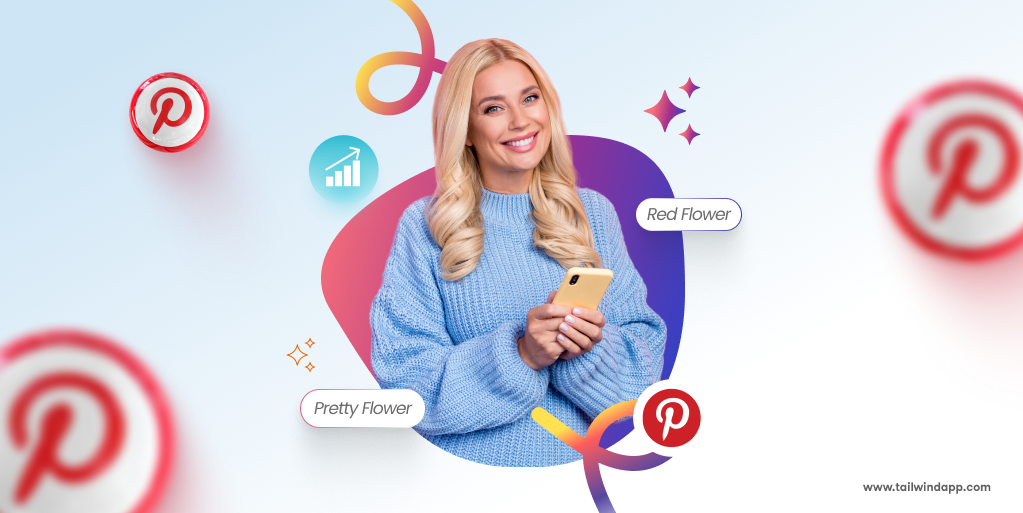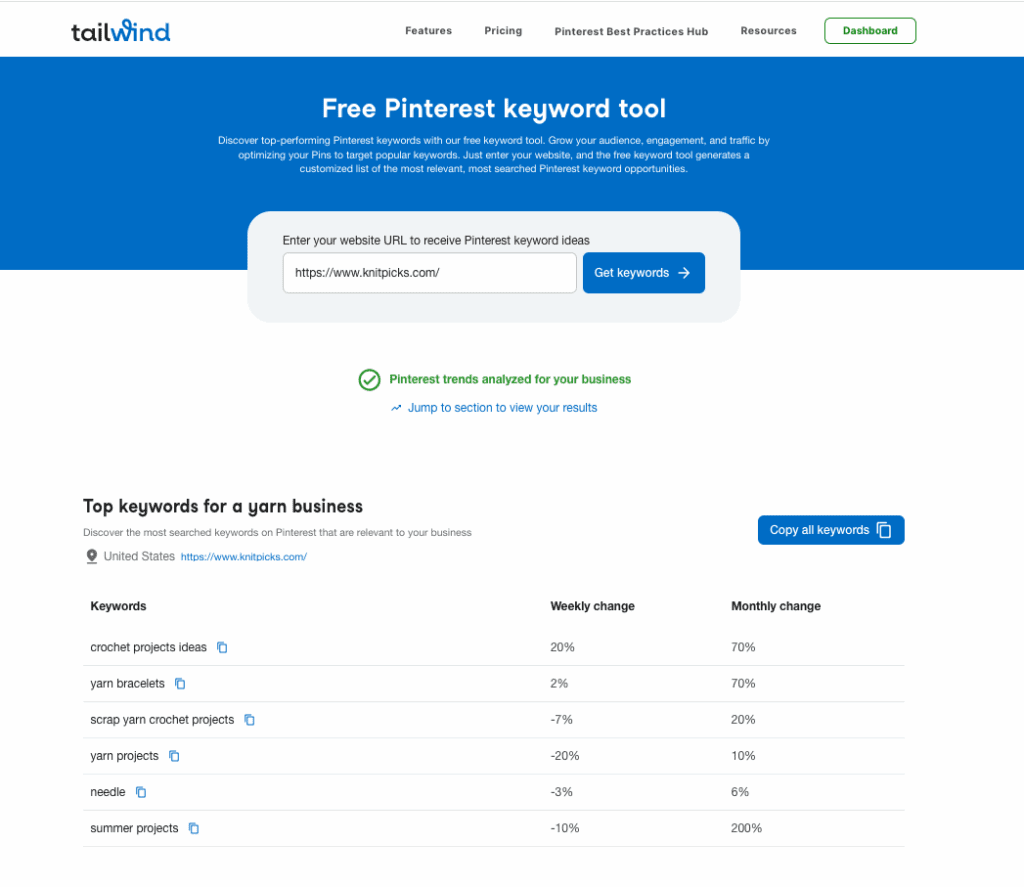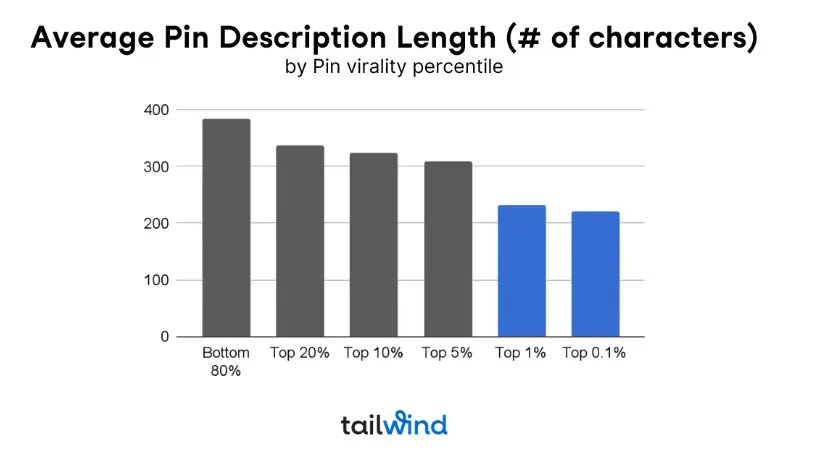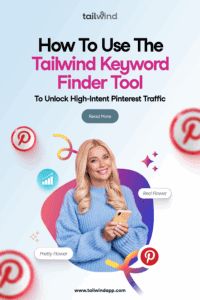
You know that feeling when you spend hours creating the perfect Pin, only to watch it disappear into the Pinterest void with barely any saves or clicks? I’ve been there, and it’s incredibly frustrating.
The truth is, even the most gorgeous Pin won’t drive traffic if it’s not optimized for what your audience is actually searching for.
That’s where smart Pinterest keyword research comes in, and specifically, why the Tailwind keyword tool has become my secret weapon for turning Pinterest into a consistent traffic-driving machine.
This isn’t about gaming the system; it’s about understanding exactly what your ideal customers are looking for and putting your content right where they’ll find it.
What Is the Tailwind Keyword Finder Tool?
The Tailwind keyword tool is a free Pinterest keyword research tool designed specifically for Pinterest marketers, e-commerce businesses, bloggers, and content creators who want to drive real traffic to their websites.
Unlike generic keyword tools that focus on Google search, this tool understands Pinterest’s unique search behavior and user intent.
What makes this tool brilliant is its simplicity and accuracy. You don’t need to be a Pinterest expert or understand complex SEO metrics. Just enter your website URL, and the tool generates a customized list of the most relevant, most searched Pinterest keyword opportunities specifically for your business.
Why Keywords Matter on Pinterest
Here’s something that completely changed how I think about Pinterest: it’s not really a social media platform at all. Pinterest is a visual search engine where people actively hunt for solutions, inspiration, and products. Over 60% of saves were from Pins over a year old, which means your content can continue driving traffic for years if you optimize it correctly.
Unlike Instagram or TikTok where your content gets buried after a few hours, Pinterest rewards content that solves real problems and answers genuine search queries. When someone searches for “budget-friendly home office ideas” or “easy meal prep for beginners,” they have clear intent: they want actionable solutions they can actually use.
This is exactly why Pinterest SEO matters so much. Without the right keywords, even the most stunning Pin will never reach the people who are actively looking for what you offer. But when you nail your Pinterest keyword strategy, your content becomes discoverable by people who are ready to engage, save, and — most importantly — click through to your website.
Getting Started with the Keyword Finder Tool
Getting started with the Tailwind keyword tool couldn’t be simpler, and the best part? It’s completely free. Head over to the Tailwind keyword tool page, and you’ll see a clean, straightforward interface with just one main input field where you’ll enter your website URL.
This is where the magic happens. Instead of making you guess which keywords might work for your business, the tool analyzes your actual website content and matches it with trending Pinterest search terms. It’s like having insider knowledge about what your potential customers are typing into Pinterest’s search bar.
Once you enter your URL and hit “Get Keywords,” the tool gets to work analyzing your content and cross-referencing it with Pinterest’s most searched terms. Within seconds, you’ll have a customized list of keyword opportunities that are specifically relevant to your business and already gaining traction on Pinterest.
How to Find the Best Keywords for Your Niche
Let me walk you through exactly how to use this tool to uncover keyword gold for your specific niche. The process is refreshingly straightforward, but the strategy behind choosing the right keywords makes all the difference.
Step 1: Enter Your URL. Start by entering your homepage URL or the URL of a specific page or product you want to promote. If you’re a jewelry business, for example, you might enter your main website URL or a specific product category page. The tool will analyze your content and generate keywords that match what you actually offer.
Step 2: Analyze Your Keyword List. Once you get your results, you’ll see a list that might look something like this for a jewelry business:
- jewelry (20% weekly change, 8% monthly change)
- summer jewelry (32% weekly change, 5% monthly change)
- vintage jewelry (57% weekly change, 13% monthly change)
- rings for men (49% weekly change, 6% monthly change)
- non traditional wedding rings (89% weekly change, 12% monthly change)
Or like this for a yarn business:

Step 3: Focus on Growth Opportunities. Pay special attention to keywords with high weekly and monthly change percentages. These indicate trending topics that are gaining momentum. A keyword like “nontraditional wedding rings” with 89% weekly growth suggests this is a hot topic that could drive significant traffic if you create content around it.
The beauty of this approach is that you’re not guessing what might work — you’re seeing real data about what your target audience is actively searching for right now.
Evaluating Keyword Quality
Not all Pinterest keywords are created equal, and understanding how to evaluate keyword quality is crucial for your success. The Tailwind keyword tool provides valuable insights through weekly and monthly change percentages, but here’s how to think about these metrics strategically:
High-growth keywords (those showing significant weekly or monthly increases) represent trending opportunities where you can potentially get in early before competition intensifies. However, don’t ignore steady-performing keywords that consistently drive searches.
Long-tail keywords like “nontraditional wedding rings” or “vintage jewelry for everyday wear” often convert better than broad terms because they show specific intent. Someone searching for “jewelry” could want anything, but someone searching for “vintage jewelry for everyday wear” knows exactly what they’re looking for.
Consider the search intent behind each keyword. A term like “pretty jewelry” suggests someone in the browsing phase, while “engagement rings” indicates someone closer to making a purchase decision. Both have value, but they serve different purposes in your content strategy.
When evaluating keywords, also think about your content capacity. If you’re a small business, you might want to focus on specific, achievable keywords rather than trying to compete with major brands on broad terms like “jewelry” or “rings.”
Adding Keywords to Your Pin Strategy
Now that you’ve identified your target Pinterest keywords, it’s time to strategically incorporate them throughout your Pinterest presence. The key is using them naturally in ways that help both Pinterest’s algorithm and your human audience understand what your content offers.
Pin Descriptions: Use your primary keyword early in your Pin description, followed by related terms that provide context. Instead of “beautiful rings for your special day,” try “nontraditional wedding rings that make a unique statement for your engagement.”
The most viral Pins tended to have shorter descriptions, averaging in the range of 220-232 characters, so be concise but keyword-rich.

Board Titles and Descriptions: Create keyword-optimized boards like “Vintage Jewelry for Everyday Style” instead of generic names like “Jewelry I Love”. Your board descriptions should naturally incorporate 3-4 related keywords while explaining what pinners will find there.
Pin Titles: Lead with your primary keyword while maintaining readability. “Summer Jewelry Trends 2025: Lightweight Pieces for Hot Weather” hits multiple keywords while providing clear value.
Profile Optimization: Include your main business keywords in your Pinterest profile description to establish topical authority and help Pinterest understand your overall content theme.
The goal is to create a cohesive keyword strategy across all your Pinterest elements, helping Pinterest’s algorithm understand your content and connect it with the right audience.
Bonus Tips to Maximize Keyword Finder Results
Want to squeeze every drop of value from the Tailwind keyword tool? Here are some advanced strategies that can significantly amplify your Pinterest success:
Create content for trending keywords quickly. When you spot a keyword with high weekly growth (like that 89% increase for “nontraditional wedding rings”), create content around it immediately. Pinterest tends to reward fresh content on trending topics.
Combine with Tailwind’s Ghostwriter for incredibly efficient workflows. Once you’ve identified your target keywords, use Ghostwriter to create optimized Pin descriptions that naturally incorporate your chosen terms while maintaining engaging, authentic copy.
Save your top-performing keywords to a master list for future content planning. When you discover keywords that consistently drive traffic and engagement, use them to inform your content calendar and ensure you’re always creating content around proven search terms.
Test seasonal variations of your keywords. The tool might show “summer jewelry” trending now, but consider how this could evolve into “fall jewelry trends” or “holiday jewelry gifts” as seasons change.
Explore related URLs to uncover more keyword opportunities. If you entered your homepage initially, try entering specific product pages or blog post URLs to discover more targeted keyword possibilities.
Common Mistakes to Avoid
Even with the best Pinterest keyword tool, there are some pitfalls that can sabotage your Pinterest success. Here’s what to watch out for:
Keyword stuffing is the fastest way to turn off both Pinterest’s algorithm and your human audience. Your Pin descriptions should read naturally and provide genuine value, not sound like a list of search terms. Focus on incorporating 3-5 relevant keywords naturally rather than cramming in every possible variation.
Ignoring search intent can lead to high bounce rates that hurt your long-term performance. If someone searching “engagement rings” lands on your Pin about jewelry care tips, they’ll leave immediately, and Pinterest will notice this mismatch.
Only targeting broad keywords means you’re always fighting uphill battles against established accounts with more authority. While it’s fine to target some competitive terms, make sure most of your strategy focuses on specific, achievable wins.
Not updating your keyword strategy as trends change. The tool shows weekly and monthly changes for a reason: Pinterest search behavior evolves quickly. Revisit your keyword research regularly to stay current with what your audience wants.
Final Thoughts
The Tailwind keyword tool isn’t just another Pinterest feature — it’s your roadmap to Pinterest success. When you understand what your audience is actually searching for and create content that delivers on those queries, everything changes. Your Pins get more visibility, your website gets more traffic, and your business grows.
The beauty of Pinterest is that Pins can continue being saved and clicked on for years. This means the keyword research you do today can continue paying dividends long into the future. Your optimized Pins become evergreen traffic sources that work for you 24/7.
Start simple: use the Tailwind keyword tool to identify 5-10 relevant keywords for your business. Create Pins that genuinely serve your audience while incorporating these terms naturally. Test, measure, and iterate based on what you learn.
Ready to Grow Your Pinterest Reach?
Stop guessing what your audience wants and start using data to guide your Pinterest strategy. The difference between Pinterest accounts that struggle and those that thrive often comes down to targeting the right keywords.
Try the Tailwind keyword tool today and discover the exact terms your audience is searching for. It’s free, it’s fast, and it could completely transform your Pinterest results.
Get started with the free Pinterest keyword tool →
 FAQ: Pinterest Keyword Strategy with Tailwind Keyword Finder
FAQ: Pinterest Keyword Strategy with Tailwind Keyword Finder
Q: Do I need a Tailwind account to use the Keyword Finder?
A: No, the Tailwind Keyword Finder is completely free to use — no account required. Just enter your website URL to get started.
Q: How often should I run keyword research for my Pinterest strategy?
A: We recommend checking keyword trends at least once per month. Pinterest search behavior can shift with seasons, holidays, and new trends.
Q: Will this tool work if my website is new or has very little content?
A: Yes, but you’ll get the best results if your site includes at least a few key product or blog pages with text content. The tool works by analyzing your content and matching it to Pinterest search trends.
Q: Can I use these keywords with Tailwind Ghostwriter?
A: Absolutely. Once you have your list of keywords, paste them into Tailwind Ghostwriter to automatically generate optimized Pin descriptions.
Q: Should I only use keywords with high growth percentages?
A: Not necessarily. Trending keywords are great, but consistent evergreen terms can also drive long-term Pinterest traffic.

The post How to Use the Tailwind Keyword Finder Tool to Unlock High-Intent Pinterest Traffic appeared first on Tailwind Blog.














